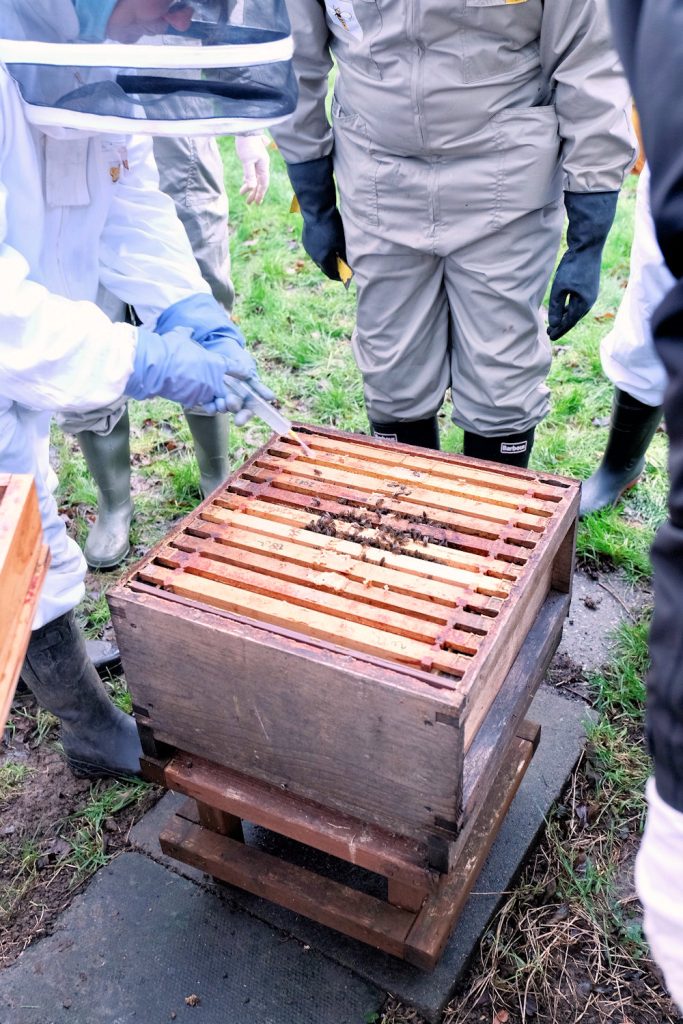OBKA Training Apiary session – Winter varroa treatment
On Sunday 31st December our hard-working Apiary Manager, Andy Pedley, arranged a session to treat the colonies at the Training Apiary for varroa. One of the key purposes of the training apiary is to have strong, healthy colonies for the Beginners Course so a winter treatment for varroa is important.
The aim of these Training Apiary sessions are not only to carry out some appropriate work in the apiary. They are also an opportunity to impart some knowledge and skills to members who might not be familiar with the techniques being used.
To this end Andy Pedley and Eric Perkins started by explaining why a varroa treatment mid-winter is important and why Oxalic Acid is the preferred treatment.
Essentially any summer treatment is unlikely to have eradicated all varroa mites and those that survive will continue to reproduce in sealed brood cells. If left unchecked there could be more varroa mites in the colony in January than at the end of the summer treatment; over several years this is a recipe for the colony succumbing to varroa.

During the winter the colony is likely to go through a broodless period. This means that any varroa mites in the colony will be phoretic, i.e. being carried on the bees – and phoretic mites are easy to kill. Oxalic acid is the preferred treatment as it is easy to administer, relatively inexpensive and well-tolerated by the bees.
Andy and Eric demonstrated the application of Oxalic Acid solution using the ‘trickling’ method; this is the easiest method to use and is recommended for beginners. We use Oxybee that needs to be made up before use according to the manufacturers’ instructions. The aim is to trickle 5-6 ml of the made-up solution to each seam (space between brood frames) that contains bees.



Photos credit Richard Stansfield

As you can see from the photos, above, the simplest way to apply the oxalic acid solution is to use a syringe. Thorne’s sell the item to the left, called a Trickle 2 (£1.31 +p&p). This holds up to 100ml of solution, is designed for one-handed use and delivers exactly 5ml per trickle. We are not promoting Thorne’s here, and there are vaguely similar items on eBay, but I personally use one of these and it makes the trickling process very easy, quick and precise.
Once all the colonies had been treated Richard Stansfield discussed the sublimation method of Oxalic acid treatment. This involves heating Oxalic acid crystals to vaporise them. This has the advantage that it is not toxic to unsealed brood (oxalic acid solution is very acidic with a pH of about 1 and larvae are not protected by an exoskeleton), well tolerated by the colony and can be done repeatedly with brood present. However it does require specialised equipment and the beekeeper must be wearing the right PPE.
Oxalic Acid treatment videos
We have two videos on the OBKA website in the Members area. The first video demonstrates both the trickle method and sublimation, whilst in the second video the trickle method is discussed and demonstrated.
The videos can be accessed here, towards the bottom of the page:
https://obka.org.uk/members-area/winter-talks-videos/
Use of approved varroacides and recording treatments
At this point we need to remind members that only approved varroacides should be used to treat honey bees. The Veterinary Medicines Regulations 2013 sets out legal text on the manufacture, authorisation, marketing, distribution and post-authorisation surveillance of veterinary medicines. Honey bees are classed as a food producing animal and therefore beekeepers must comply with these regulations.
Beekeepers must also keep documentation containing details of veterinary medicinal products administered in colonies, such as Oxalic Acid trickle treatments, for at least five years, irrespective of whether or not the colony concerned is no longer in the beekeepers possession or has died during that period. We have examples of suitable veterinary medicine record charts in the Members area of the OBKA website – click here to see them.